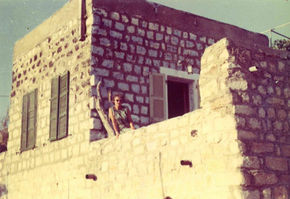
Rachel Cegla was born on the 5th of December 1912 in Hamburg, Germany. She was the daughter of a veteran Zionist leader, Dr. Willi Victor, a Hamburg –Wandsbeck lawyer, who was a delegate to the first Zionist congress in Basel in 1898. Lisbeth Victor, her mother, was a piano teacher, a daughter of the Rinteln family from Kassel, who were well known judges and lawyers.
Rachel started to paint in her early years and was accepted to the Hamburg "Academy of Fine Arts" in 1929, where she studied with Professor Adler till 1933.
In 1933 after the Nazi terror started in Germany, her family fled from Germany and found a home in Palestine. In the coming year she met Juda Cegla, a successful manufacturer of vegetable oils in Tel-Aviv who as well escaped from Nazi Germany in 1933. They were married in 1936.
Rachel continued to paint and joined internships with different Israeli painters. In 1957 she became a member of the "Israeli Painters and Sculptor Association". Since then she repeatedly took part in numerous exhibitions in galleries and museums in Israel, Europe, United States, and South America. Especially important were her first exhibitions in her birth country Germany in Hamburg, Berlin, Munster and at the Staatsoper in Munich in the late 1980's.
Rachel Cegla moved to the artist colony in Safed, Israel, in 1960. She renovated an old houses in the Old Town into her studio and gallery, using to spend the summers in the hills of the Galilee and the mysticism of old Safed. The move had great influence on her works.
Her paintings are found in many private collections and museums in Israel and abroad.
After a long life filled with passion to colors and music leaving behind her timeless paintings, Rachel died at the age of 98 on July the 25th, 2011 in Tel-Aviv.
Rachel Cegla has been in love with the sites of the Holy Land from the moment she stepped ashore. She found a new home.
Her oils, aquarelles, and monotypes are showing her love to the country, its old houses, harbors, markets, cafés, its rivers in sunlight, and Jerusalem, the center of all.
She is fascinated by the orient and its population, its variety of flowers, the smell, the music and its changing colors produced by the changing sunshine during the day.
While she has painted many oils, her preferred media are watercolors. As anyone who has ever applied himself to watercolors knows very well, the aquarelles is the most elusive and most difficult of all media, for it demands the utmost spontaneity of vision and swiftness of work. If one stroke goes wrong, the artist might just as well abandon the painting, for, unlike an oil, an aquarelle cannot be worked over, but it catches the moment , the color and light of that very second of beauty the artist sees.
But Rachel Cegla did not stop here; she created little worlds of imaginative beauty above and around the natural beauty of the land, the people, the music and even the modern silhouettes of Tel-Aviv or New-York. She took as many liberties with the motif as she had in order to create, through tonalities, colors, shapes, and lines, her scene of life, between past and future, between music, flowers, her Jerusalem and her mysticism of life.
























